Reorientation of Cryogenic Liquids
Experiments were performed to investigate the axial sloshing and thermodynamic effects of cryogenic argon, methane, neon and hydrogen. These liquids were kept in a cylindrical vessel with superheated walls and exposed to a step reduction of gravity in the drop tower facility.
Motivation
In spacecrafts large amounts of cryogenic propellants are stored. After the engine propelled parts of it and gets shut down, the volume forces on the liquids gets compensated by the coasting of the spacecraft. This is called compensated gravity, micro gravity or, more common, weightlessness. In this domain the liquid is dominated by its surface- or capillary-forces. It rises at the superheated tank-walls and starts a transition to the capillary-forces-dominated steady state, called interface reorientation.
Physics
In large containers and under normal gravity liquids are dominated by their volume forces and show a flat interface with small meniscii in the vicinity of the vessel wall. Under micro gravity conditions this changes to a surface with a constant curvature, dominated by its surface tension and the static contact angle. Since cryogenic liquids show an ideal wetting behavior on solids and the gravity residuals are small, the surface under micro gravity is a hemisphere. This holds true for the isothermal steady state.
Upon the reduction of gravity there is no smooth transition from the 1g steady state to the micro gravity steady state. Instead, the first rise at the wall overshoots the steady state configuration and the liquid interface enters a damped axial sloshing motion. There is no analytical solution for its frequency yet since the potential flow theory does not apply for small contact angles.
In rocket upper stages the walls are not isothermal but strongly stratified due to solar radiation. This causes the evaporation of liquid in the vicinity of the wall, which changes the apparent contact angle in two ways: First liquid in the meniscus evaporates, second the evaporation causes a vapor recoil on the liquid surface. This increase of the contact angle also increases the sloshing frequency.
Experiments
The experimental apparatus is a helium or nitrogen cooled cryostat with a cylindrical test cell mounted inside. The test cell is made from borosilicate glass, so optical observation by an endoscope and laser illumination is suitable.
The cryogenic liquid gets condensed inside the test cell prior to the test campaign. Along its wall and inside the test cell there are several temperature sensors mounted to determine the stratification in the liquid, its vapor and the solid. Furthermore there are three heating foils mounted at the bottom, at the connecting flange and around the test cell to apply the desired stratification. A pressure transducer logs the pressure progression during the experiment. An overview of the tested cryogenic liquids is given below. Once the desired conditions are established the experiment starts with the drop of 4.74s.
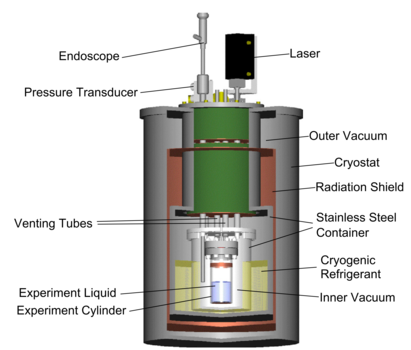
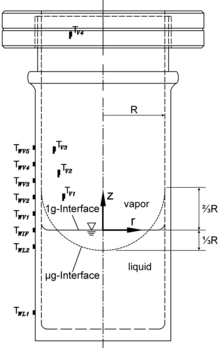
| Property | Temperature | Density | Kinematic viscosity | Surface tension | Heat capacity | Thermal conductivity | Heat of evaporation | |
| Unit | K | kg/m³ | m²/s | N / m | J/(kg K) | W/(m K) | J/kg | |
| Argon | liquid | 87.2 | 1396.2 | 1.95E-07 | 0.0126 | 1117.1 | 0.1258 | 161233 |
| vapor | 87.2 | 5.7 | 1.25E-06 | 565.4 | 0.0055 | |||
| Methane | liquid | 111.5 | 422.6 | 2.77E-07 | 0.0133 | 3479.9 | 0.1841 | 511117 |
| vapor | 111.5 | 1.8 | 2.48E-06 | 2216.5 | 0.0116 | |||
| Neon | liquid | 27.1 | 1207.7 | 9.66E-08 | 0.0045 | 1861.3 | 0.1553 | 85801 |
| vapor | 27.1 | 9.5 | 4.78E-07 | 1420.8 | 0.0067 | |||
| Hydrogen | liquid | 20.2 | 70.8 | 1.88E-07 | 0.0019 | 9629.4 | 0.1034 | 445641 |
| vapor | 20.2 | 1.3 | 8.09E-07 | 12214.0 | 0.0170 | |||
| Water (for comparison) | liquid | 372.8 | 958.6 | 2.95E-07 | 0.0590 | 4215.2 | 0.6790 | 2257400 |
| vapor | 372.8 | 0.6 | 2.08E-05 | 2078.4 | 0.0251 |
Results
Right after the drop the liquid rises at the wall and evaporation occurs, depending on the wall superheat. The images below give an impression of an experiment with liquid hydrogen at time frames of special interest.
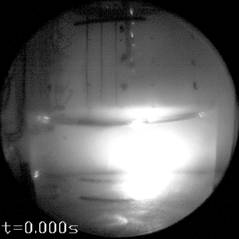
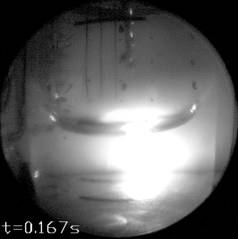
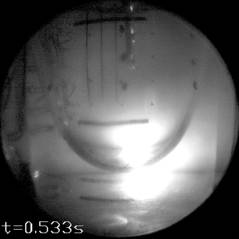
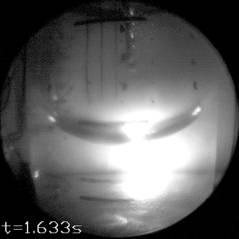
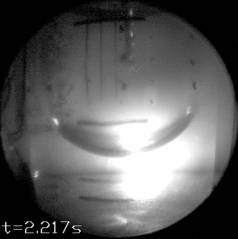
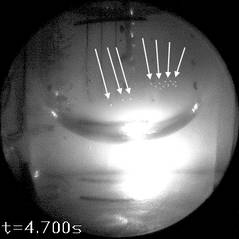
Since the apparent contact angle is influenced by the evaporation, the sloshing period and therefore the frequency depends on the wall superheat.
Acknowledgement
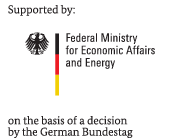
The project under the grant number 50RL1621 is funded with means of the German Federal Ministry for Economic Affairs and Energy through the German Aerospace Center (DLR e.V.).
Contact
Publications
Nikolai Kulev & Michael E. Dreyer. 2010. Drop Tower Experiments on Non-isothermal Reorientation of Cryogenic Liquids. Microgravity Sci. Technol. 22.4. 463–474.
Nikolai Kulev, Steffen Basting, Eberhard Baensch & Michael E. Dreyer. 2014. Interface reorientation of cryogenic liquids under non-isothermal boundary conditions. Cryogenics 62. 48–59.
Sebastian Schmitt & Michael E. Dreyer. 2015. Free surface oscillations of liquid hydrogen in microgravity conditions. Cryogenics 72.1. 22–35.


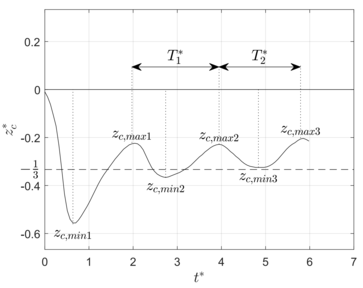
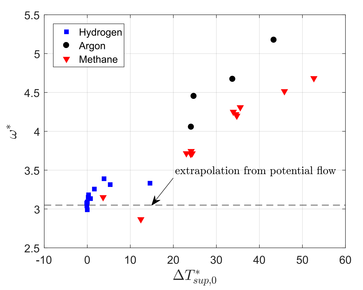
 "
"